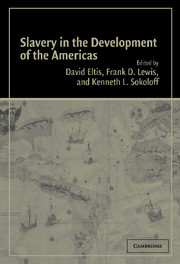Book contents
- Frontmatter
- Contents
- Appreciation: Stanley L. Engerman and Slavery
- Introduction
- PART I ESTABLISHING THE SYSTEM
- PART II PATTERNS OF SLAVE USE
- PART III PRODUCTIVITY CHANGE AND ITS IMPLICATIONS
- 6 Prices of African Slaves Newly Arrived in the Americas, 1673–1865: New Evidence on Long-Run Trends and Regional Differentials
- 7 American Slave Markets During the 1850s: Slave Price Rises in the United States, Cuba, and Brazil in Comparative Perspective
- 8 The Relative Efficiency of Free and Slave Agriculture in the Antebellum United States: A Stochastic Production Frontier Approach
- PART IV IMPLICATIONS FOR DISTRIBUTION AND GROWTH
- The Writings of Stanley L. Engerman
- Contributors
- Index
7 - American Slave Markets During the 1850s: Slave Price Rises in the United States, Cuba, and Brazil in Comparative Perspective
Published online by Cambridge University Press: 18 August 2009
- Frontmatter
- Contents
- Appreciation: Stanley L. Engerman and Slavery
- Introduction
- PART I ESTABLISHING THE SYSTEM
- PART II PATTERNS OF SLAVE USE
- PART III PRODUCTIVITY CHANGE AND ITS IMPLICATIONS
- 6 Prices of African Slaves Newly Arrived in the Americas, 1673–1865: New Evidence on Long-Run Trends and Regional Differentials
- 7 American Slave Markets During the 1850s: Slave Price Rises in the United States, Cuba, and Brazil in Comparative Perspective
- 8 The Relative Efficiency of Free and Slave Agriculture in the Antebellum United States: A Stochastic Production Frontier Approach
- PART IV IMPLICATIONS FOR DISTRIBUTION AND GROWTH
- The Writings of Stanley L. Engerman
- Contributors
- Index
Summary
For well over fifty years, historians studying slavery in the Western Hemisphere have been drawn to comparative aspects of slave systems in the Americas. The publication of Frank Tannenbaum's Slave and Citizen in 1947 established the broad parameters of consideration by dividing slavery into two fundamentally different systems. Slavery in the United States and in another entity referred to uniformly as Latin America was deemed to be not one but two distinct institutions despite the obvious legalistic similarities in the consideration of slaves as property. Furthermore, race relations and the dynamics of racism after slavery was abolished were also framed in a dichotomous fashion. Tannenbaum's arguments and conceptualizations of U.S. and Latin American variants in New World slave systems were reinforced by Stanley Elkins over a decade later, and together the “Tannenbaum–Elkins thesis” served as an important reference point in the development of slave studies, particularly in the United States. The parameters of their arguments, and the many scholarly responses which followed, are well known and hardly need repeating.
Despite the repudiation of many of Tannenbaum's and Elkins' ideas in the historiography of slavery and race relations in the Americas over the past half century, especially the notion of a more benign institution in Latin America, it is generally accepted that indeed there were great differences in the way slavery developed in the United States and in Latin America and the Caribbean.
- Type
- Chapter
- Information
- Slavery in the Development of the Americas , pp. 219 - 235Publisher: Cambridge University PressPrint publication year: 2004
- 2
- Cited by

